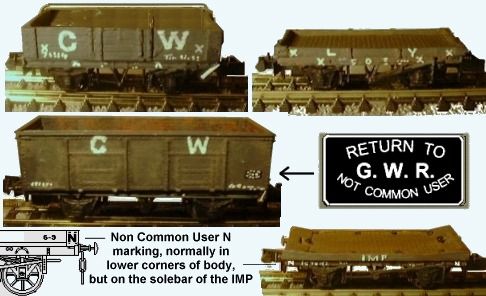During the First World War a proportion of each of the British railway companies rolling stock was allocated to a pool of 'common user' stock, in fact unless specially marked any wagon would be assumed to be such. When a 'common user' wagon wandered onto another company's rails they were permitted to retain the 'foreign' wagon and use it as required. The RCH then determined any payment to be made to the parent company. Every now and again a rake of empty wagons might be formed and returned to the parent company but in general the stock remained in a fair balance. The common user system reduced the empty wagon mileage from 60% of the total before the war to only 20% of the total by 1918. This was self evidently a commercial success and the scheme remained in operation right up to the nationalisation of the railways after the Second World War.
Obviously the companies would reserve any special stock for their own use, but there were variations in what the companies considered special. For example the LMS, LNER and SR pooled their cattle wagons under the RCH 'common user' scheme in 1927, the GWR however did not place their cattle wagons in the pool. More specialised livestock vehicles, such as horse boxes, were not pooled by any of the companies and other specialised rolling stock such as grain hoppers, banana vans and fruit vans would also be reserved. These `non common user' vehicles were marked as such and had to be returned to the parent company as soon as possible after unloading, fees being paid if they were retained.
Railway company owned tarpaulin sheets were brought into the Common User scheme in about 1917. In the main they would stay with a particular wagon but it would be possible to see for example an LNER wagon sheet draped over an LMS wagon. Sheets were easier to return than wagons however, so this would not have been common.
The pooling of railway company stock was such an evident success that a common user pool was also established for private owner vehicles. The wagons belonging to the pool were clearly marked as such and the RCH determined any payments required for the use of a pooled wagon. The private owner pool markings were common from the 1920's until the Second World War, they are described and illustrated in the section on Livery Information - Private Owner Liveries.
Markings associated with Common User Stock
Initially the common use scheme only applied to wagons of over three planks in height, not including vacuum braked wagons or wagons with hinged tarpaulin rails. Some companies wished to pool wagons which fell outside this specification so these wagons needed to be marked in some way. The standard marking was two X shapes in the lower corners of the body with two more, inset slightly, on the solebar. I have to date only seen wagons belonging to the GWR and L&YR carrying these markings.
Following the grouping of 1923 the scheme was extended to more and more vehicle types and the requirement changed to marking stock which was reserved from the pool for the operating companies own use. The LMS, LNER and SR settled on a six inch high letter N in the lower corner of the body, the GWR adopted a metal plate as shown in the illustration below.
Fig___ Markings associated with Common User Stock

The four-plank GWR wagon has a sheet supporter (and possibly a vacuum brake) and carried the four X markings. The L&Y one plank wagon would not normally be included due to its low height but as the L&Y operated large numbers of this type they marked some for common use, again with the four X markings. The GW 21 ton mineral wagon shows the post grouping 'Not In Common Use' plate, this was usually mounted as shown in the lower right of the body but occasionally I have seen examples with the plate mounted centrally on the body side. The N marking was usually in the lower corners of the body sides, often on the corner plate. The NER implement wagon has no body as such so the markings were on the solebars close to the ends. There would be an N marking toward each end of both sides of the vehicle.